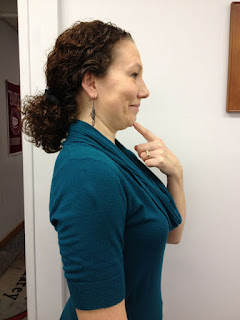 Going
head first, as the expression goes, refers to not taking time to think about
your actions before starting whatever it is that you're doing. The results with this sort of approach, as
one can imagine, can be mixed. On the
other hand, the "head first" scenario that I am referring to, from
the perspective of a health care practitioner, is that of anterior head
carriage (AHC), where the potential for negative outcomes is the clear
winner. AHC refers to loss of vertical
alignment of your head over your torso, where a plumb line should pass through the
flap at the front of your ear and the tip of your shoulder when viewed from the
side. Instead, the head is shifted forward
in relation to the shoulders. It is
synonymous with forward head posture or simply "bad posture" as so
many of us have been told. In this
position the lower neck and upper back are excessively bent forward whereas the
upper neck, the area just below the back of our head, is in hyper-extension. This causes increased strain on the tissues
at these levels and frequently results in pain and/or other symptoms. Neck pain, headaches, jaw (i.e. TMJ) pain,
pain into the upper back or around the shoulder blades, and symptoms such as
pain, tingling, numbness, or weakness in the arms and hands are common
examples.
Going
head first, as the expression goes, refers to not taking time to think about
your actions before starting whatever it is that you're doing. The results with this sort of approach, as
one can imagine, can be mixed. On the
other hand, the "head first" scenario that I am referring to, from
the perspective of a health care practitioner, is that of anterior head
carriage (AHC), where the potential for negative outcomes is the clear
winner. AHC refers to loss of vertical
alignment of your head over your torso, where a plumb line should pass through the
flap at the front of your ear and the tip of your shoulder when viewed from the
side. Instead, the head is shifted forward
in relation to the shoulders. It is
synonymous with forward head posture or simply "bad posture" as so
many of us have been told. In this
position the lower neck and upper back are excessively bent forward whereas the
upper neck, the area just below the back of our head, is in hyper-extension. This causes increased strain on the tissues
at these levels and frequently results in pain and/or other symptoms. Neck pain, headaches, jaw (i.e. TMJ) pain,
pain into the upper back or around the shoulder blades, and symptoms such as
pain, tingling, numbness, or weakness in the arms and hands are common
examples.
It
is easy to appreciate the increased strain on the body in this position. I often pose a question to patients -
"Would you rather hold a weight in front of your chest all day or with
your arms fully extended with the weight as far away from the body as
possible?" Unless your goal is to
get an exhausting workout the answer to keep the weight close and decrease
leverage is obvious. However, to correct
this problem, the direct approach of saying "improve your posture",
"sit up straight", or "don't slouch", doesn't work well in
my experience. Similarly, how often does
saying don't smoke or don't eat junk food really work? Ultimately, you need to create an environment
for success. With the goal of a better
head position, you can support a better posture by setting up your desk,
computer, car seat, etc. in such a way that you don't get lured forward. Keep your chair close to the desk, your
computer monitor or steering wheel close to you, and your buttocks all the way
back on the chair. Better yet, employ a
good lumbar support to keep your low back curved nicely and you'll notice that
it is much more difficult to poke your chin out. Your neck and low back will thank you.
An
exercise for your deep neck flexor muscles can also be done periodically to
improve the alignment of your head and neck and to balance out strains in the
involved tissues. Often called chin
tucks, neck retractions, or the "give yourself a double chin"
exercise, you can do it in either a seated position or lying on your back. While keeping your eyes looking forward, the
object is to draw your chin back as far as possible. This extends the lower neck and flexes the
upper neck, the exact opposite positions involved with poor posture. Hold the end position for 1-2 seconds and
repeat for 10 repetitions. Doing a few
sets daily can go a long way in preventing pain and symptoms related to AHC
This article is for
general information purposes only and is not to be taken as professional
medical advice.

No comments:
Post a Comment